A Smart Heating System Based on Integrated Renewable Energy Sources for Swine Nursery Buildings
Abstract
1. Introduction
2. Materials and Methods
2.1. Study Case
2.2. Outline of the Implemented RES System
2.3. Methodology for Data Analysis
- From 10 to 17 April: The weather at the farm site was very sunny, with an average irradiance during the day of around 300 W/m2 and a peak of 970 W/m2 (Figure 8). The outdoor temperature in the period was high as well, with a mean of over 20 °C, above the average value recorded for April in the previous years. In this period, the PVT and the solar central station both activated and solar heat energy was injected into the BTES.
- From 17 to 25 April, the weather temperature abruptly dropped, with reduced sun and the presence of precipitation on various days. The average weather temperature reduced to 11 °C, with low peaks down to 2.5 °C during the night. During the period, a high variability of weather temperature occurred (Figure 9). In these conditions, the hallway of the piglets’ building started to drop its ambient temperature, and the heat pump automatically activated to provide the necessary comfort by extracting the heat from the borehole heat exchangers (BHEs) of the BTES and, working in hybrid mode, from the ambient air.
3. Results and Discussion
3.1. Implementation of the Integrated RES System
3.2. Performance of the Integrated RES Heating System
3.3. Performance of the Hybrid Geothermal–Air Heat Pump
- The hallway must keep a minimum temperature of 14 °C;
- The outlet heating temperature from the DSHP to the hallway can reach a maximum of 50 °C;
- The upper limit of the cooling water temperature to deactivate the circulation pump is 10 °C;
- The ground is the preliminary source of heat for the heat pump (GEO mode);
- The standard temperature difference between the inlet and outlet from the ground side is about 3 K;
- The lower limit of the inlet ground temperature to the DSHP for activating the fans (HYBRID mode) is 3 °C;
- The lower limit of the inlet ground temperature to the DSHP for deactivating the geothermal mode is 2 °C (air mode).
3.4. Environmental and Energy Benefits
4. Conclusions
Author Contributions
Funding
Data Availability Statement
Acknowledgments
Conflicts of Interest
Abbreviations
| BHE | Borehole Heat Exchanger |
| BTES | Borehole Thermal Energy Storage |
| COP | Coefficient of Performance |
| DSHP | Dual Source Heat Pump |
| GHG | Greenhouse Gas |
| HVAC | Heating, Ventilation, Air Conditioning |
| LPG | Liquefied Petroleum Gas |
| PVT | Photovoltaic–Thermal |
| RES | Renewable Energy Source |
| SDG | Sustainable Development Goal |
| SPF | Seasonal Performance Factor |
| TRT | Thermal Response Test |
References
- Lagua, E.B.; Mun, H.-S.; Ampode, K.M.B.; Chem, V.; Park, H.-R.; Kim, Y.-H.; Yang, C.-J. Monitoring Using Artificial Intelligence Reveals Critical Links between Housing Conditions and Respiratory Health in Pigs. J. Anim. Behav. Biometeorol. 2024, 12, e2024008. [Google Scholar] [CrossRef]
- Niu, K.; Zhong, J.; Hu, X. Impacts of Climate Change-Induced Heat Stress on Pig Productivity in China. Sci. Total Environ. 2024, 908, 168215. [Google Scholar] [CrossRef]
- Costantino, A. Development, Validation, and Application of Building Energy Simulation Models for Livestock Houses: A Systematic Review. Agriculture 2023, 13, 2280. [Google Scholar] [CrossRef]
- Kim, J.; Lee, I.; Aarnink, A.; Lee, B.; Jeong, D.; Jeong, H.; Kim, S.; Lee, B.; Lee, D. Development and Validation of an Air Recirculated Ventilation System, Part 1: Application of System in a Pig Farm and Evaluation of Pig Productivity during Winter. Biosyst. Eng. 2023, 230, 106–130. [Google Scholar] [CrossRef]
- Tyris, D.; Manolakos, D.; Bartzanas, T.; Benni, S.; Amon, T.; Maselyne, J.; Lecompte, S.; Grammelis, P.; Balafoutis, A.; Zhang, G.; et al. RES4LIVE–Energy Smart Livestock Farming towards Zero Fossil Fuel Consumption. VDI Berichte 2022, 2022, 493–498. [Google Scholar] [CrossRef]
- Deeken, H.F.; Lengling, A.; Krommweh, M.S.; Büscher, W. Improvement of Piglet Rearing’s Energy Efficiency and Sustainability Using Air-to-Air Heat Exchangers—A Two-Year Case Study. Energies 2023, 16, 1799. [Google Scholar] [CrossRef]
- Elqadhi, M.E.; Skrbic, S.; Mohamoud, O.; Asonja, A. Energy Integration of Corn Cob in the Process of Drying the Corn Seeds. Therm. Sci. 2024, 28, 3325–3336. [Google Scholar] [CrossRef]
- Hahn, C.; Lindkvist, E.; Magnusson, D.; Johansson, M. The Role of Agriculture in a Sustainable Energy System–The Farmers’ Perspective. Renew. Sustain. Energy Rev. 2025, 213, 115437. [Google Scholar] [CrossRef]
- Nikolić, D.; Jovanović, S.; Jurišević, N.; Nikolić, N.; Radulović, J.; Velemir Radović, M.; Grujić, I. Sustainable Design in Agriculture—Energy Optimization of Solar Greenhouses with Renewable Energy Technologies. Energies 2025, 18, 416. [Google Scholar] [CrossRef]
- Benni, S.; Tinti, F.; Bovo, M.; Barbaresi, A.; Torreggiani, D.; Tassinari, P. An Integrated Renewable Energy Plant with Smart Monitoring System for Sustainable Farming. In Proceedings of the 2023 IEEE International Workshop on Metrology for Agriculture and Forestry (MetroAgriFor), Pisa, Italy, 6–8 November 2023; pp. 547–552. [Google Scholar]
- Mun, H.-S.; Dilawar, M.A.; Mahfuz, S.; Ampode, K.M.B.; Chem, V.; Kim, Y.-H.; Moon, J.-P.; Yang, C.-J. Effects of a Combined Geothermal and Solar Heating System as a Renewable Energy Source in a Pig House and Estimation of Energy Consumption Using Artificial Intelligence-Based Prediction Model. Animals 2022, 12, 2860. [Google Scholar] [CrossRef]
- Jeong, D.-Y.; Jo, S.-K.; Lee, I.-B.; Shin, H.; Kim, J.-G. Digital Twin Application: Making a Virtual Pig House Toward Digital Livestock Farming. IEEE Access 2023, 11, 121592–121602. [Google Scholar] [CrossRef]
- Kwak, Y.; Shin, H.; Kang, M.; Mun, S.-H.; Jo, S.-K.; Kim, S.-H.; Huh, J.-H. Energy Modeling of Pig Houses: A South Korean Feasibility Study. Energy Strategy Rev. 2021, 36, 100672. [Google Scholar] [CrossRef]
- Mahfuz, S.; Mun, H.-S.; Dilawar, M.A.; Yang, C.-J. Applications of Smart Technology as a Sustainable Strategy in Modern Swine Farming. Sustainability 2022, 14, 2607. [Google Scholar] [CrossRef]
- Bilardo, M.; Comba, L.; Cornale, P.; Costantino, A.; Fabrizio, E. Relation between Energy Use and Indoor Thermal Environment in Animal Husbandry: A Case Study. E3S Web Conf. 2019, 111, 01042. [Google Scholar] [CrossRef]
- Du, L.; Yang, L.; Yang, C.; Hu, C.; Yu, C.; Qiu, M.; Liu, S.; Zhu, S.; Ye, X. Development and Validation of an Energy Consumption Model for Animal Houses Achieving Precision Livestock Farming. Animals 2022, 12, 2580. [Google Scholar] [CrossRef] [PubMed]
- Pezzuolo, A.; Chiumenti, A.; Sartori, L.; Da Borso, F. Automatic Feeding System: Evaluation of Energy Consumption and Labour Requirement in North-East Italy Dairy Farm. Eng. Rural Dev. 2016, 15, 882–887. [Google Scholar]
- Alberti, L.; Antelmi, M.; Angelotti, A.; Formentin, G. Geothermal Heat Pumps for Sustainable Farm Climatization and Field Irrigation. Agric. Water Manag. 2018, 195, 187–200. [Google Scholar] [CrossRef]
- Tinti, F.; Tassinari, P.; Rapti, D.; Benni, S. Development of a Pilot Borehole Storage System of Solar Thermal Energy: Modeling, Design, and Installation. Sustainability 2023, 15, 7432. [Google Scholar] [CrossRef]
- Murali, D.; Acosta-Pazmiño, I.P.; Loris, A.; García, A.C.; Benni, S.; Tinti, F.; Gomes, J. Experimental Assessment of a Solar Photovoltaic-Thermal System in a Livestock Farm in Italy. Sol. Energy Adv. 2024, 4, 100051. [Google Scholar] [CrossRef]
- Silveira, R.M.F.; Mcmanus, C.; da Siva, I.J.O. Global Trends and Research Frontiers on Machine Learning in Sustainable Animal Production in Times of Climate Change: Bibliometric Analysis Aimed at Insights and Orientations for the Coming Decades. Environ. Sustain. Indic. 2025, 26, 100563. [Google Scholar] [CrossRef]
- Shin, H.; Lee, S.; Kim, J.; Park, D.-H.; Jo, S.-K.; Kwak, Y. Applicability Evaluation of a Temperature Humidity Index-Controlled Ventilation System in Livestock Using a Building Energy Simulation Model. Case Stud. Therm. Eng. 2024, 57, 104335. [Google Scholar] [CrossRef]
- Fourier, J.B.J. Théorie Analytique de La Chaleur; Gauthier-Villars: Paris, France, 1888; Volume 1. [Google Scholar]
- Bosma, J. Heat Pumps for Energy Efficiency and Environmental Progress; Elsevier Science: Amsterdam, The Netherlands, 2012; ISBN 9780444596550. [Google Scholar]
- ISPRA. Fattori Di Emissione Di CO2 Nel Settore Elettrico e Analisi Della Decomposizione Delle Emissioni; ISPRA: Rome, Italy, 2012. [Google Scholar]



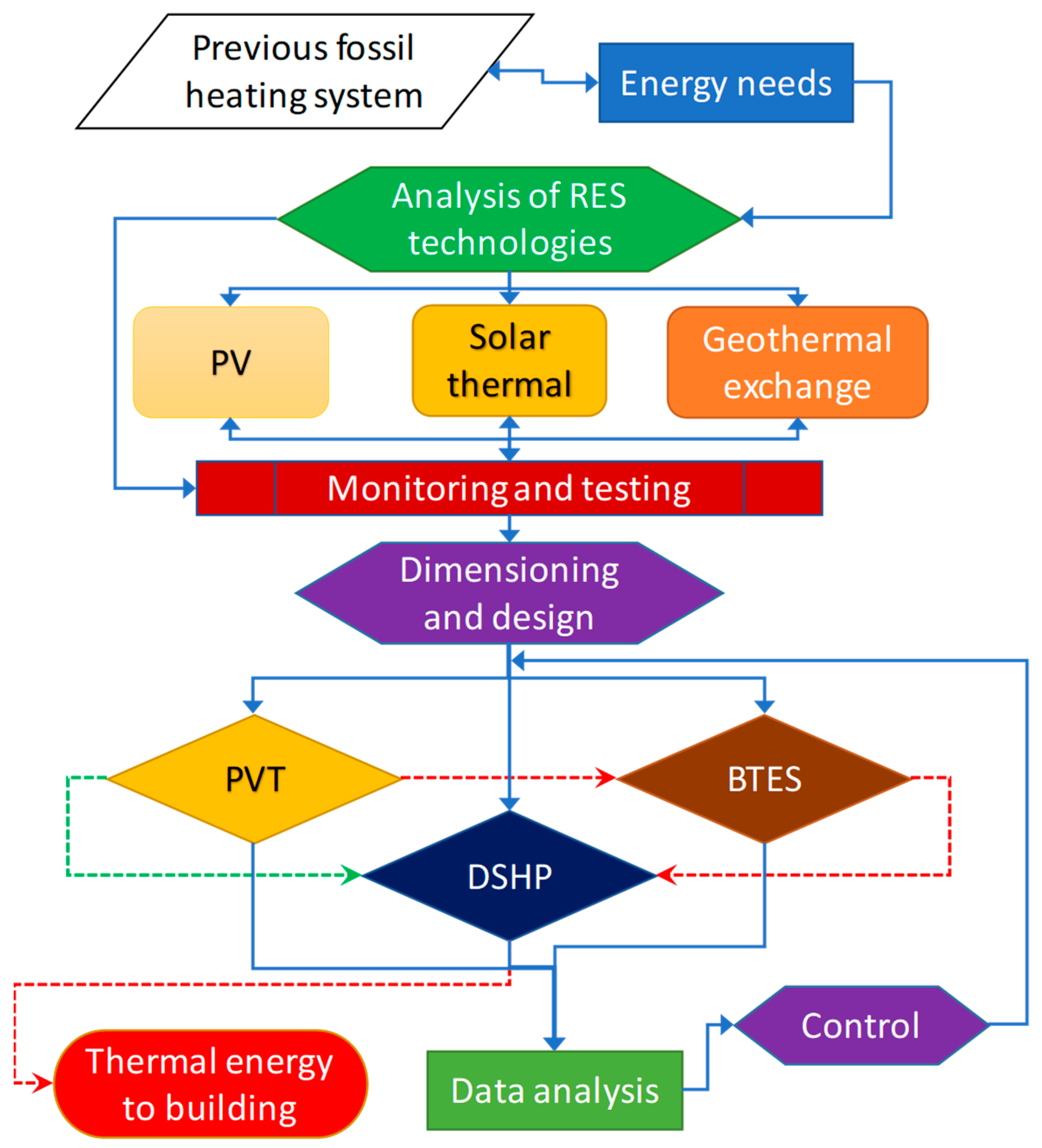

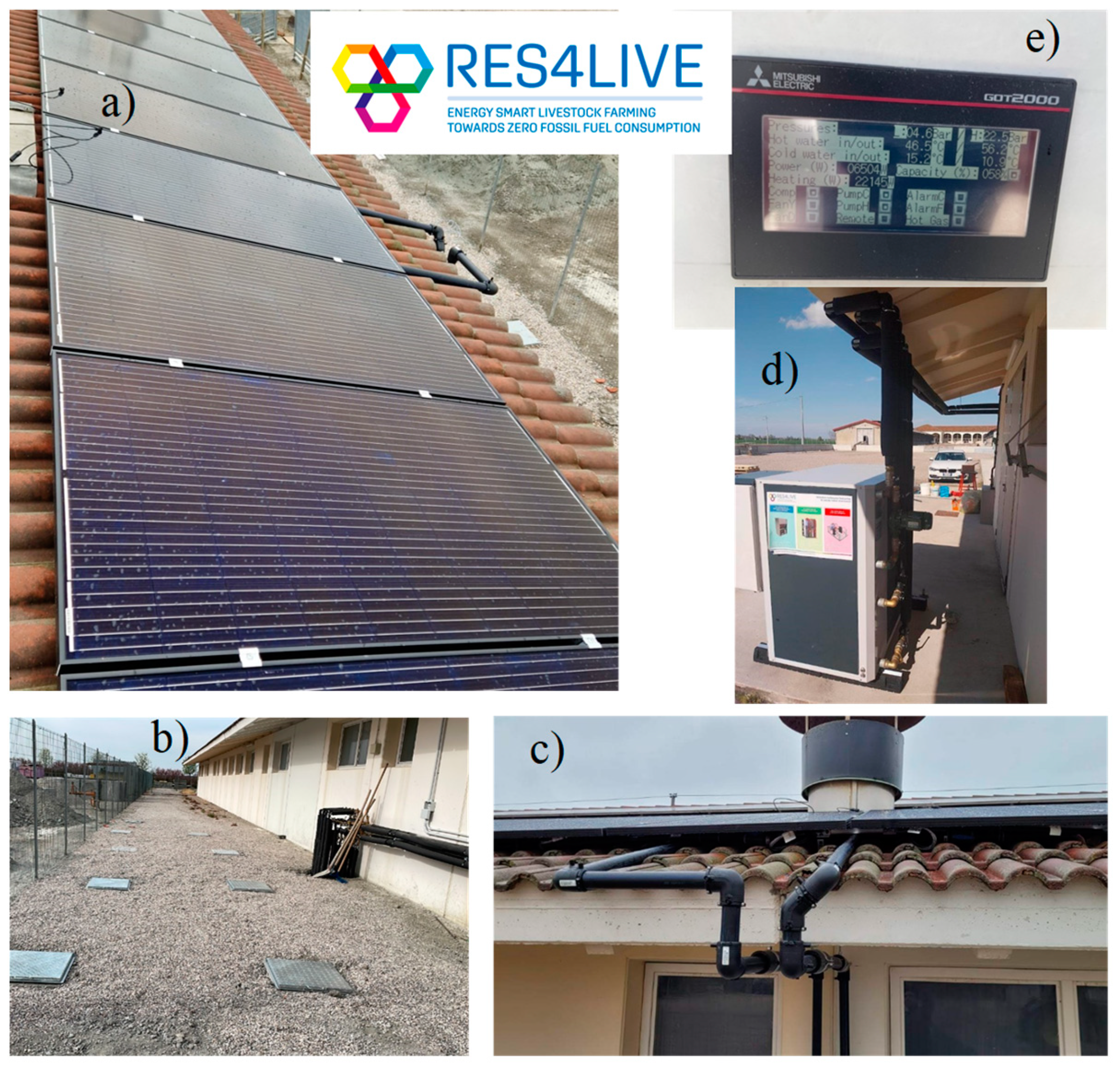
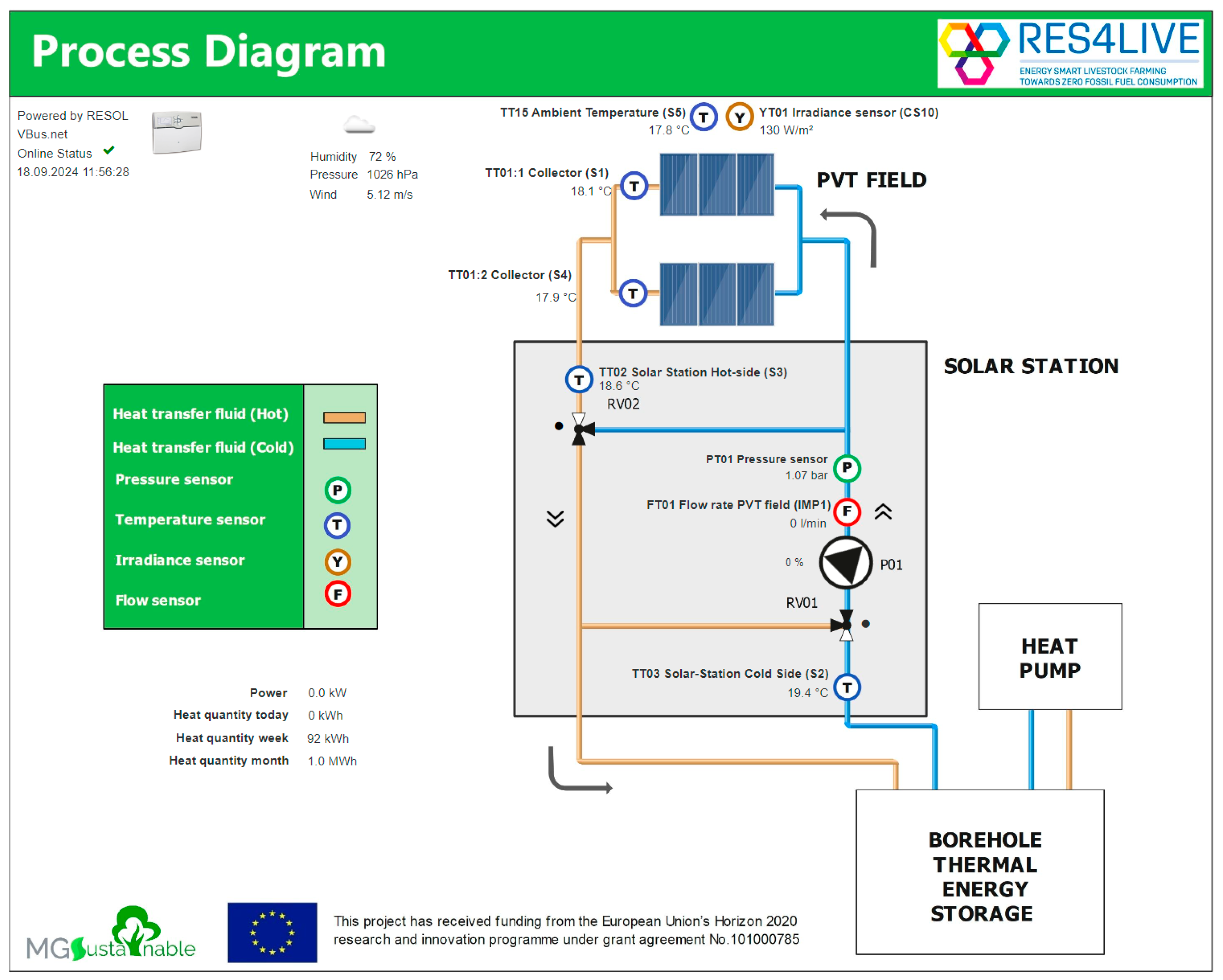
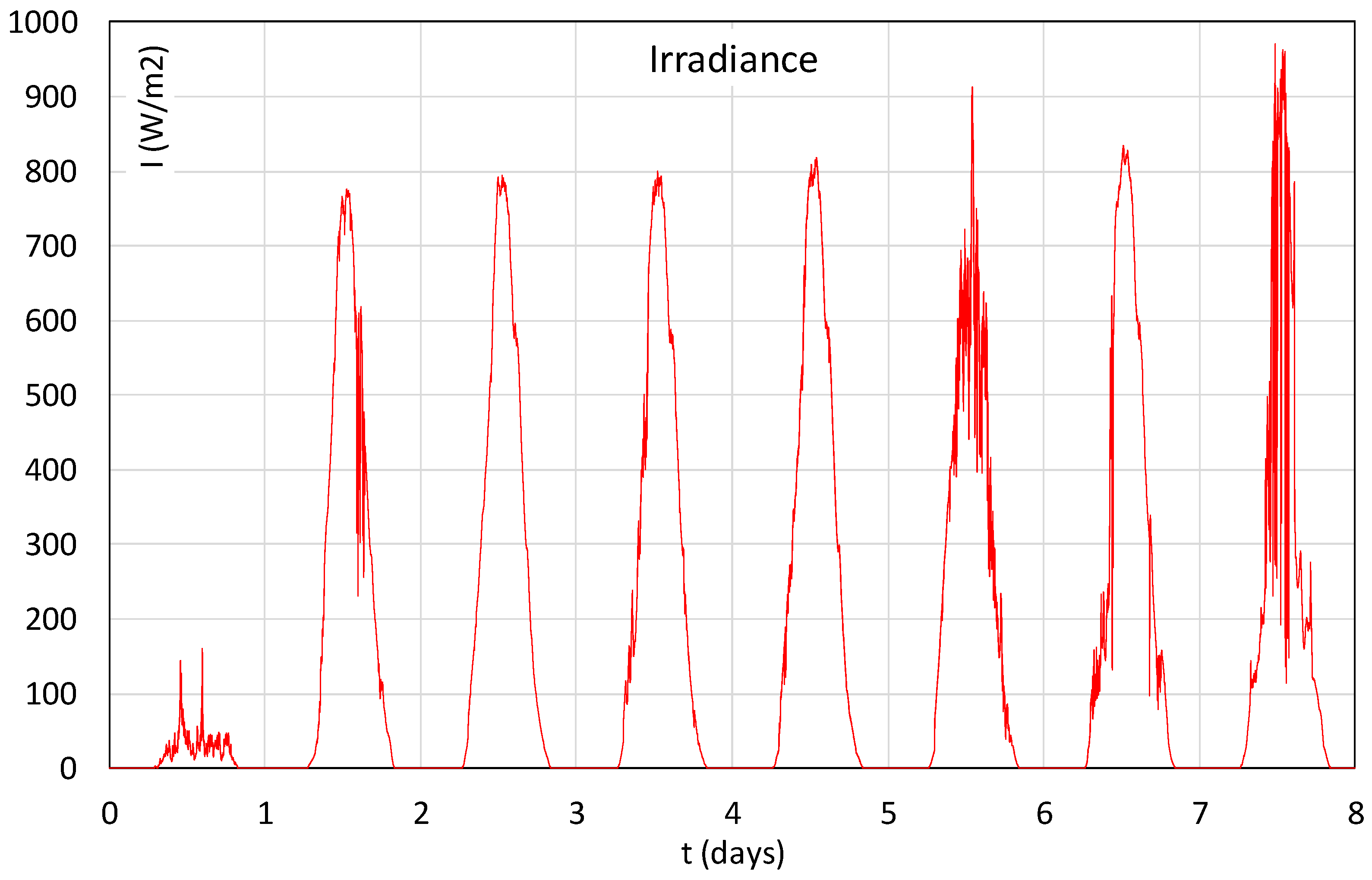


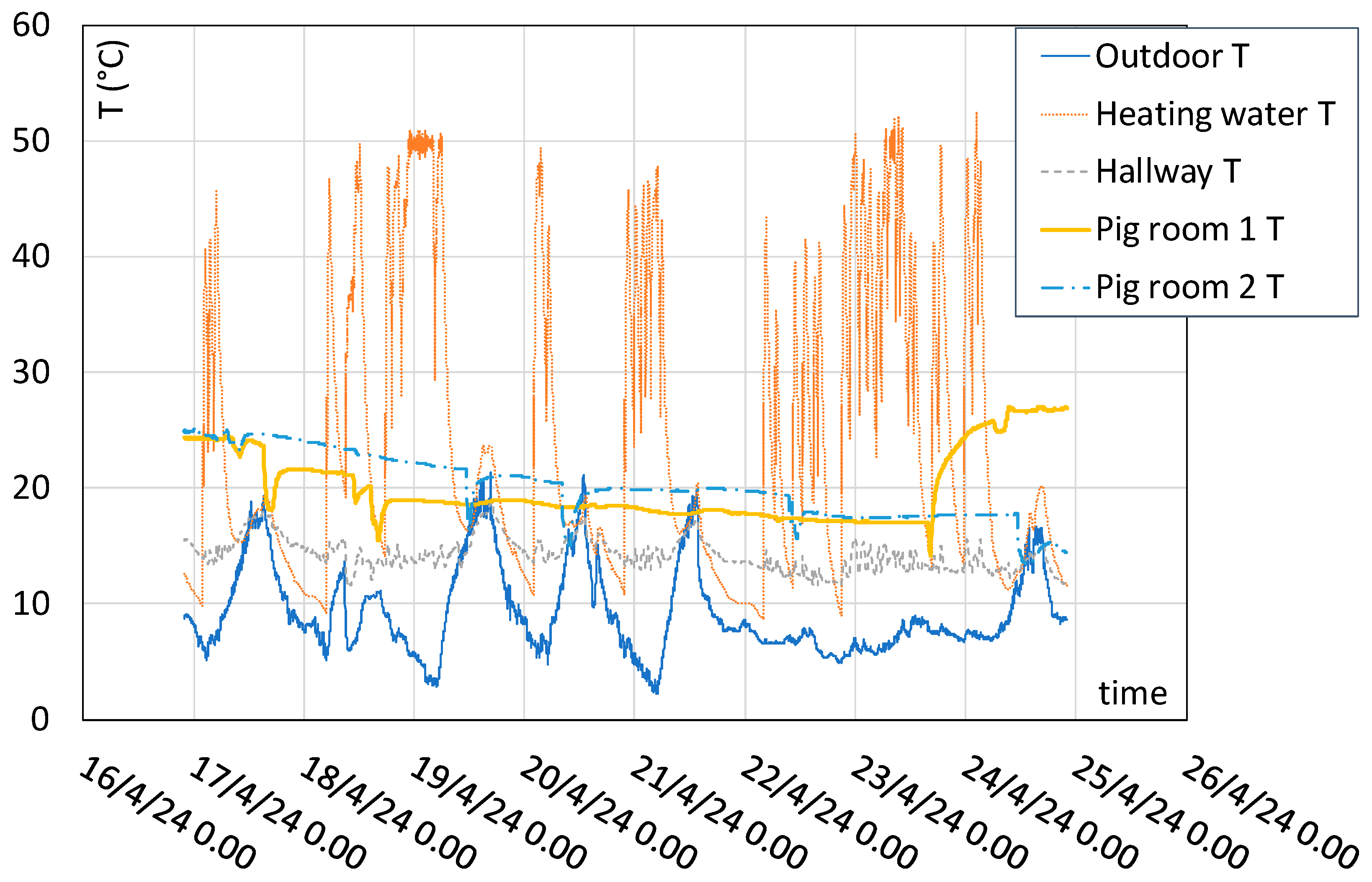
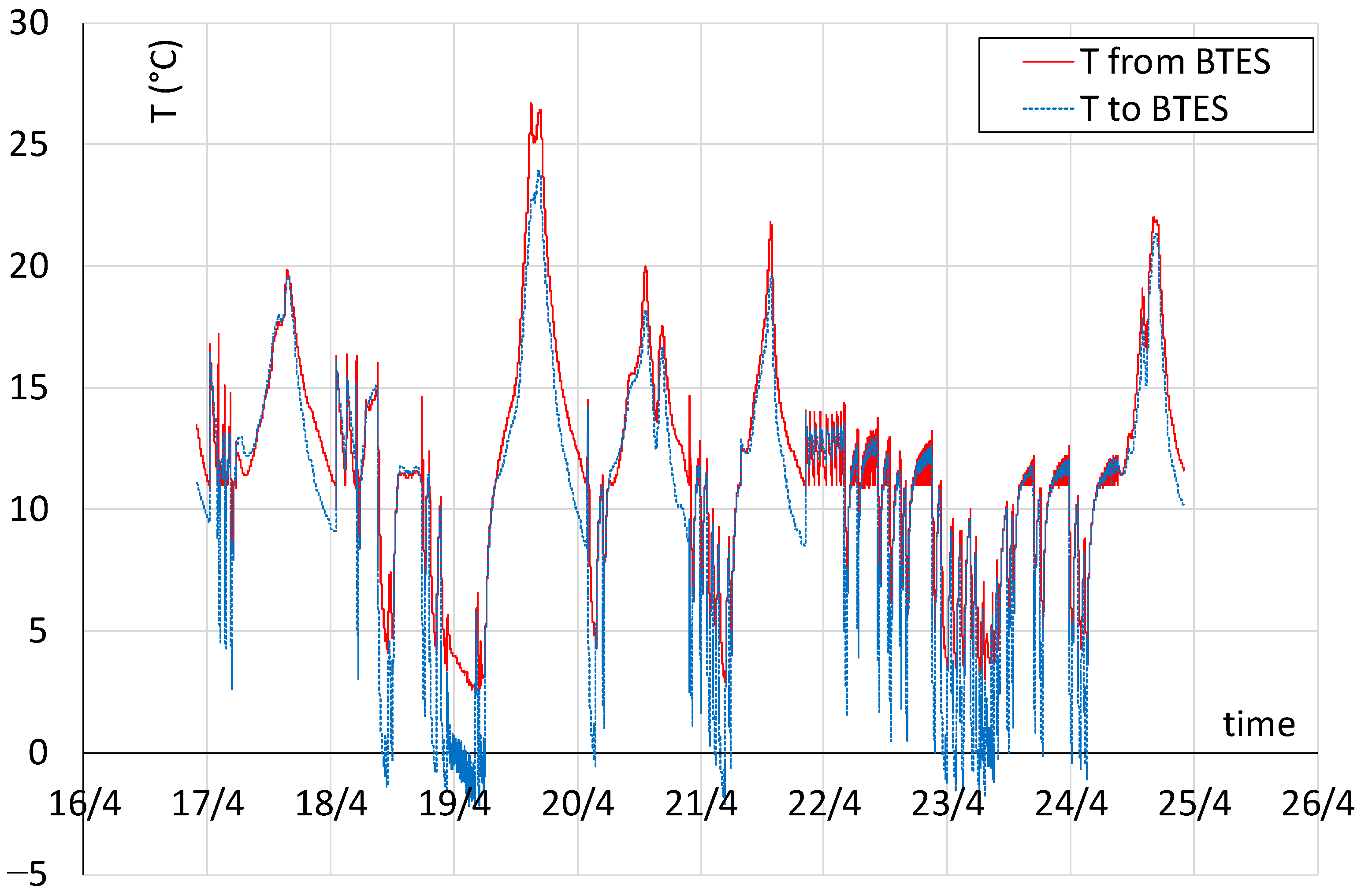
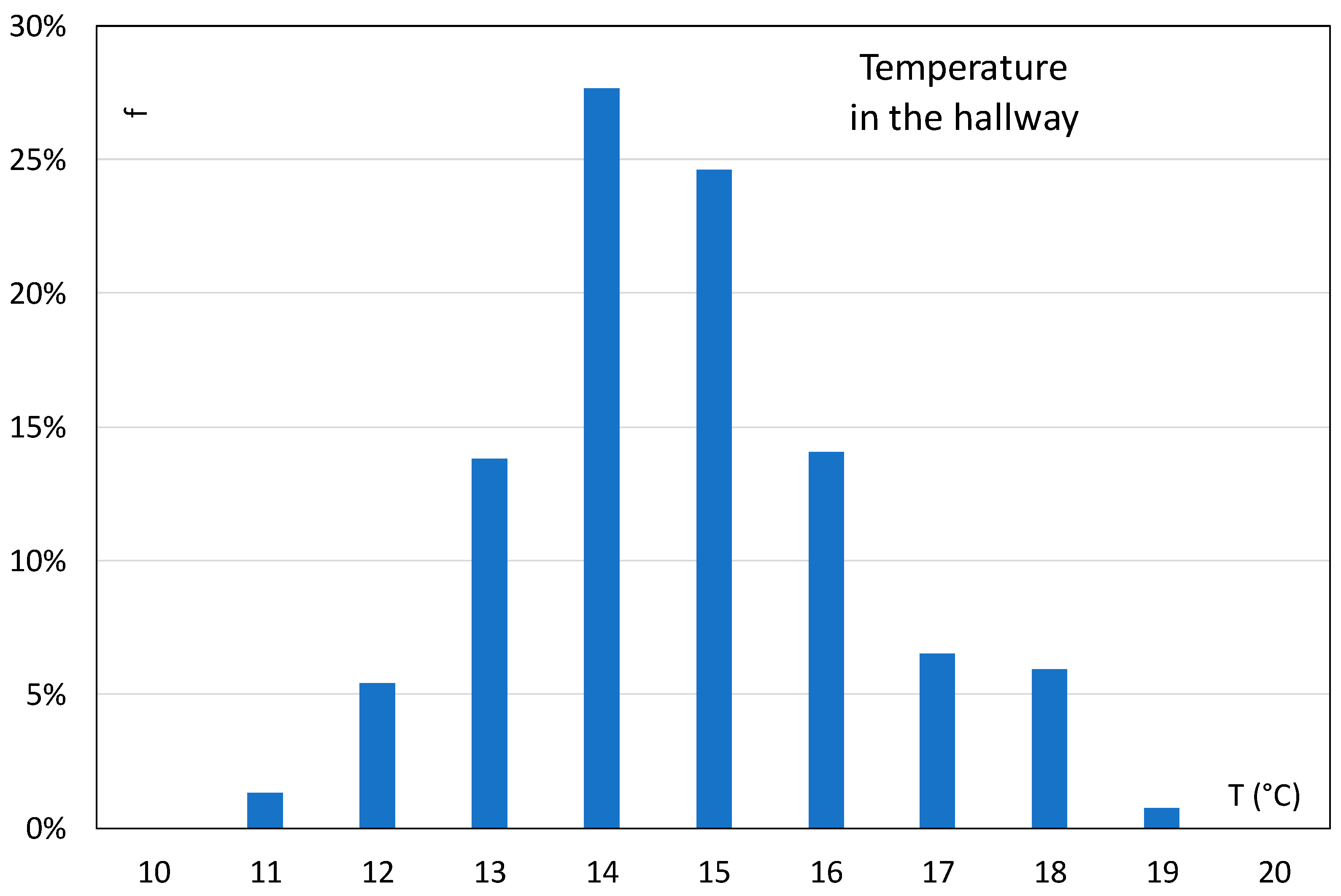
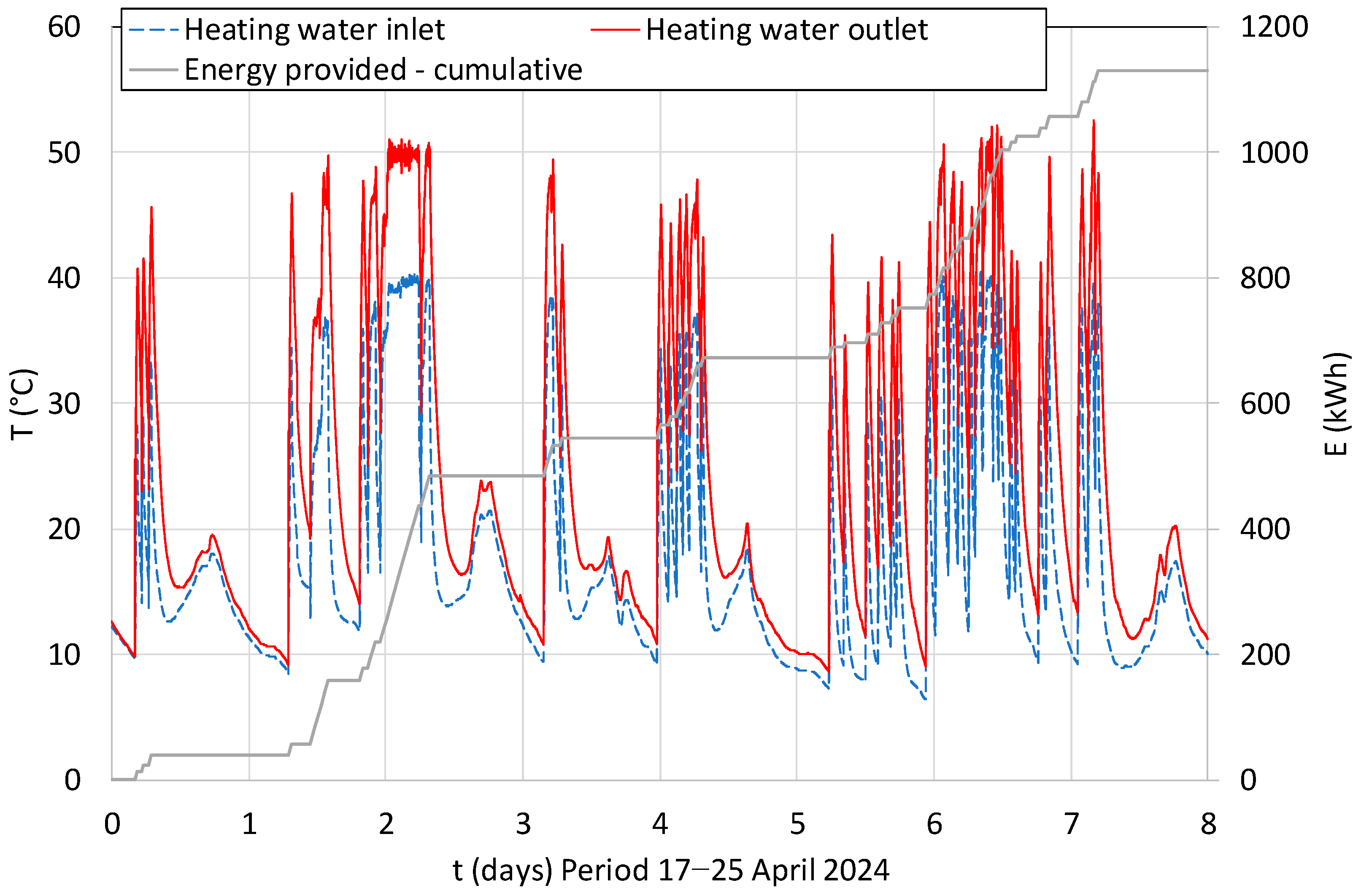
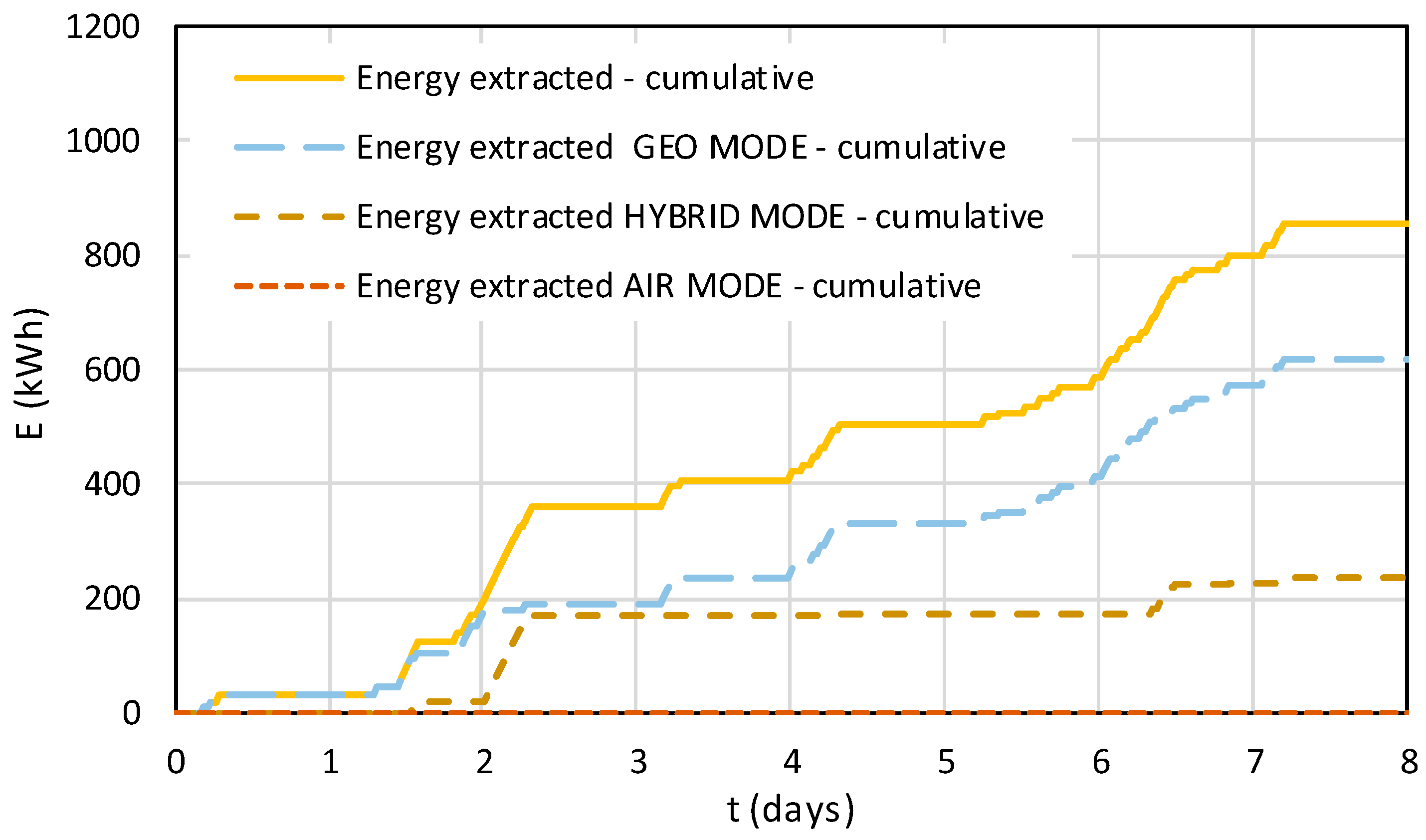

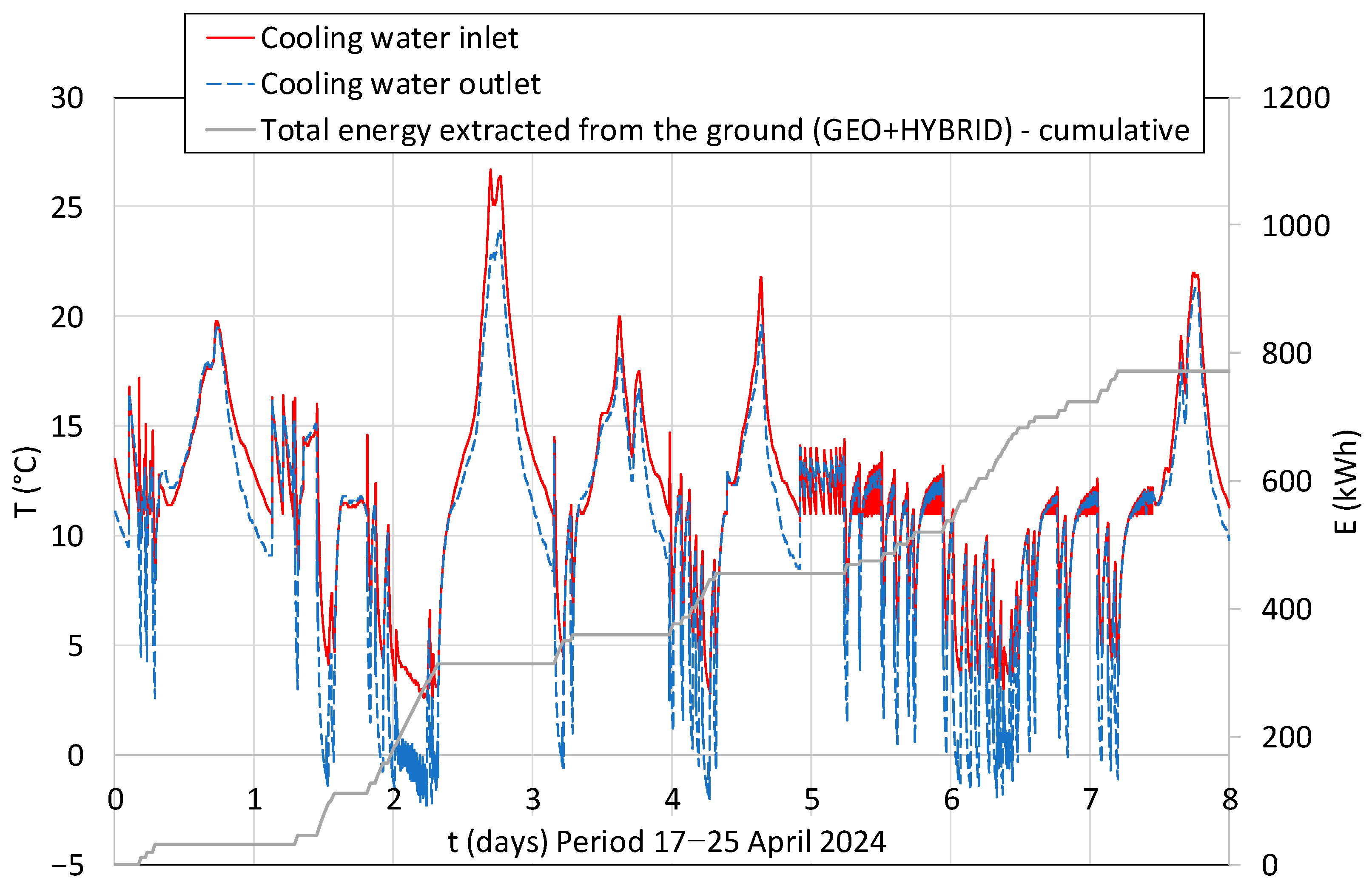

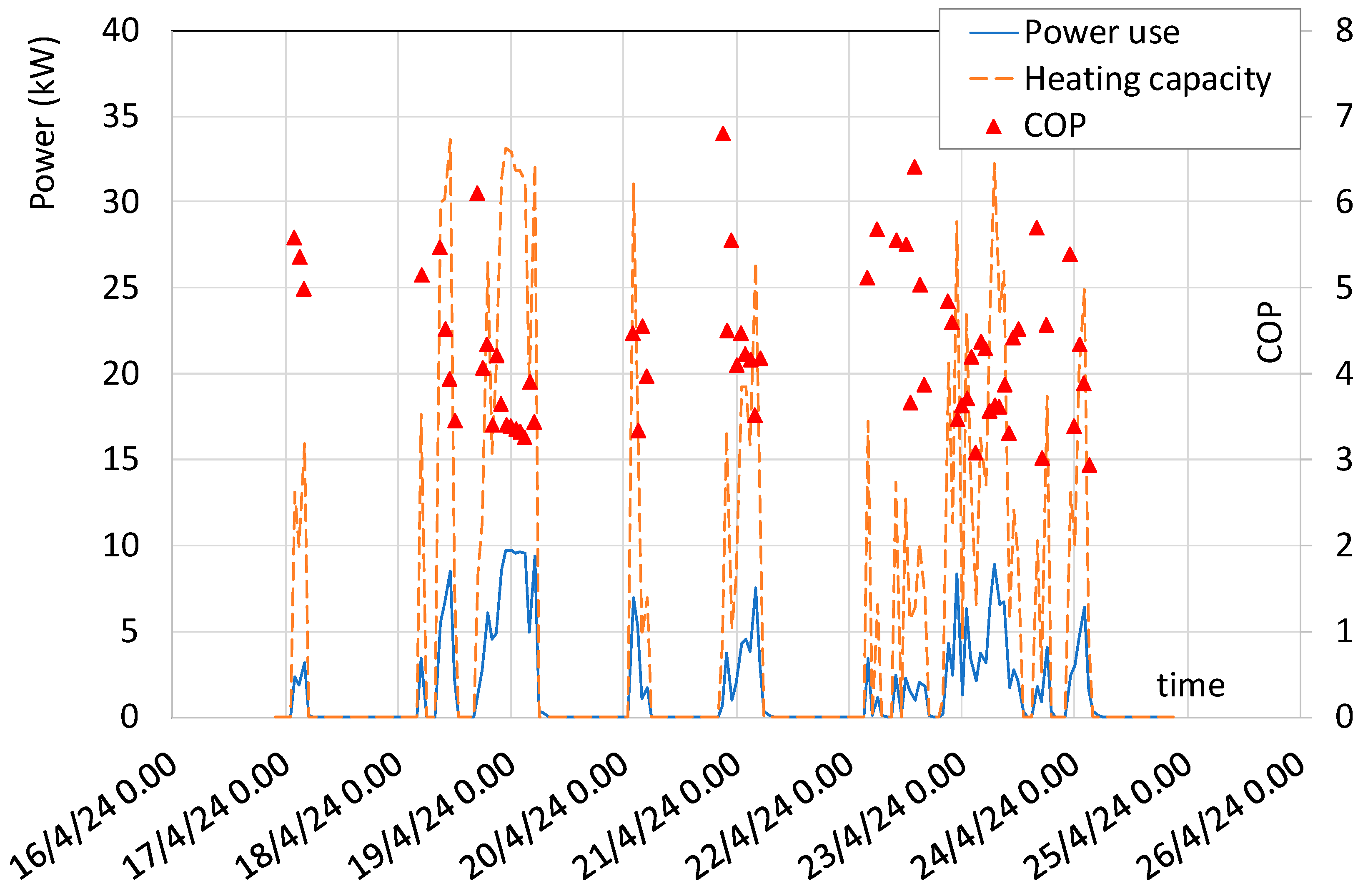
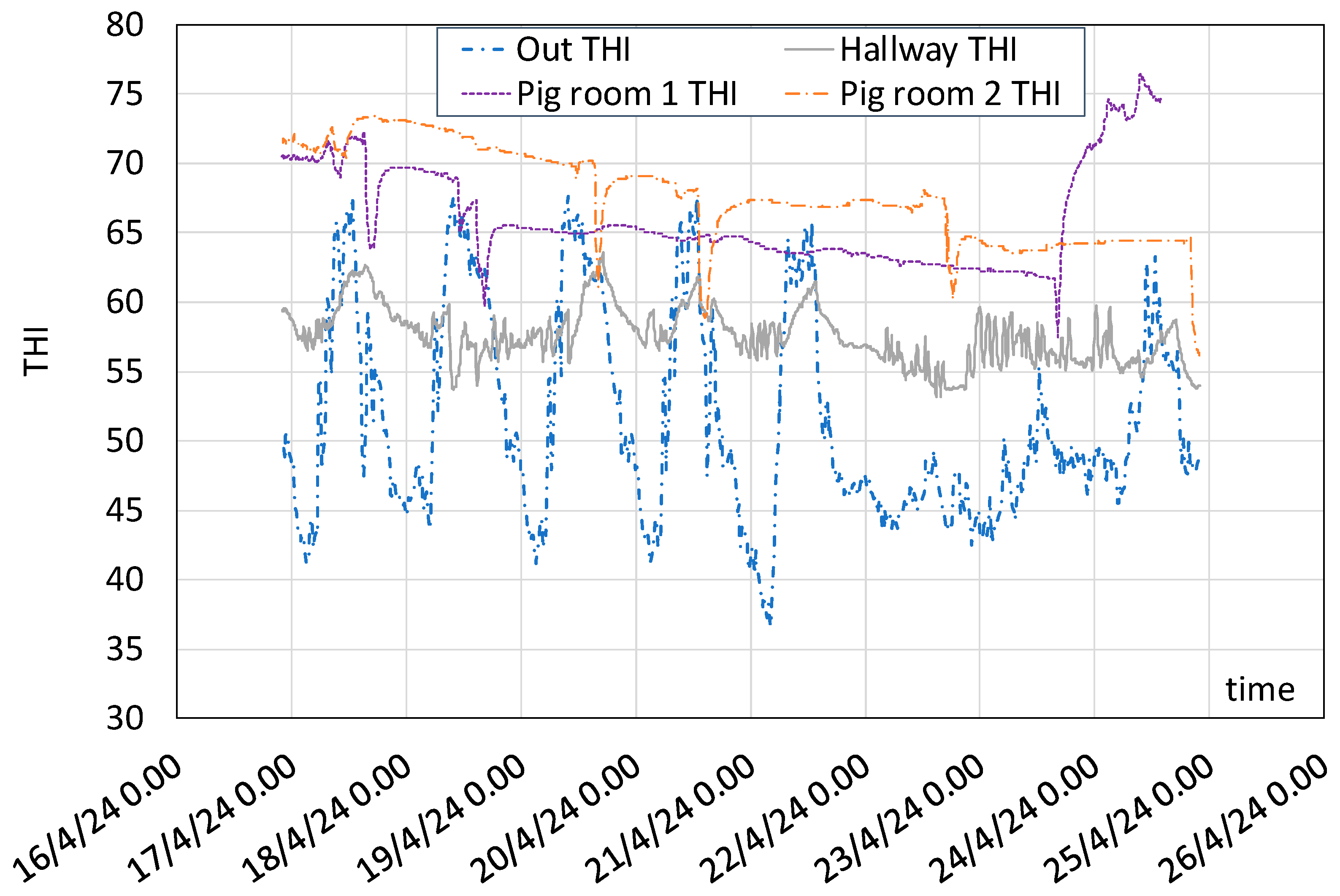
| Weather Temperature (°C) | Temperature in the Hallway (°C) | |
|---|---|---|
| Q0—Minimum temperature | 2.6 | 10.6 |
| Q1 | 7.84 | 13.18 |
| Q2—Median | 9.18 | 14.07 |
| Q3 | 12.68 | 15.14 |
| Q4—Maximum temperature | 22.84 | 18.86 |
| Mode | 8.72 | 13.88 |
| Mean | 10.51 | 14.24 |
| Standard deviation | 4.02 | 1.54 |
| Average COP | |
|---|---|
| GROUND mode | 4.67 |
| AIR mode | No activation |
| HYBRID mode | 3.50 |
| TOTAL | 4.34 |
| LPG | Electricity | |
|---|---|---|
| Heating value (H) | 12.7 kWh kg−1 | - |
| Primary energy factor (Fpr) | 1.05 | 2.42 |
| CO2 emissions factor (FCO2) | 3.03 kgCO2,eq kg−1 | 0.39 kgCO2,eq kWh−1 |
| Unit cost (Cu) | EUR 0.8 kg−1 | EUR 0.2 kWh−1 |
| LPG Boiler | DSHP | Difference | |
|---|---|---|---|
| Primary energy consumed | 1269.84 kWhpr | 718.81 kWhpr | −43.39% |
| GHG emissions | 229.34 kgCO2,eq | 115.84 kgCO2,eq | −49.49% |
| Total cost | 151.38 € | 59.41 € | −60.76% |
Disclaimer/Publisher’s Note: The statements, opinions and data contained in all publications are solely those of the individual author(s) and contributor(s) and not of MDPI and/or the editor(s). MDPI and/or the editor(s) disclaim responsibility for any injury to people or property resulting from any ideas, methods, instructions or products referred to in the content. |
© 2025 by the authors. Licensee MDPI, Basel, Switzerland. This article is an open access article distributed under the terms and conditions of the Creative Commons Attribution (CC BY) license (https://creativecommons.org/licenses/by/4.0/).
Share and Cite
Benni, S.; Garcia, C.A.P.; Bovo, M.; Barbaresi, A.; Tinti, F.; Loris, A.; Acosta-Pazmiño, I.P.; Bakalis, P.; Tassinari, P.; Torreggiani, D. A Smart Heating System Based on Integrated Renewable Energy Sources for Swine Nursery Buildings. Energies 2025, 18, 1393. https://doi.org/10.3390/en18061393
Benni S, Garcia CAP, Bovo M, Barbaresi A, Tinti F, Loris A, Acosta-Pazmiño IP, Bakalis P, Tassinari P, Torreggiani D. A Smart Heating System Based on Integrated Renewable Energy Sources for Swine Nursery Buildings. Energies. 2025; 18(6):1393. https://doi.org/10.3390/en18061393
Chicago/Turabian StyleBenni, Stefano, Carlos Alejandro Perez Garcia, Marco Bovo, Alberto Barbaresi, Francesco Tinti, Alexander Loris, Iván P. Acosta-Pazmiño, Panteleimon Bakalis, Patrizia Tassinari, and Daniele Torreggiani. 2025. "A Smart Heating System Based on Integrated Renewable Energy Sources for Swine Nursery Buildings" Energies 18, no. 6: 1393. https://doi.org/10.3390/en18061393
APA StyleBenni, S., Garcia, C. A. P., Bovo, M., Barbaresi, A., Tinti, F., Loris, A., Acosta-Pazmiño, I. P., Bakalis, P., Tassinari, P., & Torreggiani, D. (2025). A Smart Heating System Based on Integrated Renewable Energy Sources for Swine Nursery Buildings. Energies, 18(6), 1393. https://doi.org/10.3390/en18061393










